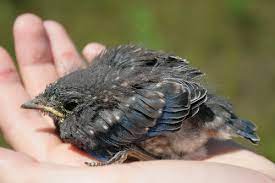I received another email yesterday about birds falling out of their nests. The emailer didn’t say where he lived but indicated that he was picking up several young birds that he assumed fell from their nests. Well, as I have said so many times in so many places, young birds rarely fall from their nests; it just wouldn’t be very adaptive and evolution would put severe restrictions on such behavior. Now, certainly, if a branch on which the nest sits falls or there is a heavy rain or windstorm, it certainly is possible for birds to be ejected from their nest. Most frequently, though, when someone calls or emails me and describes what they see, it’s usually a young, feathered bird on the ground.

Fledged Eastern Bluebird
Newly hatched birds develop in stages. The first is the nestling stage where they are confined to the nest and are totally dependent on their parents for food and warmth. Once they develop enough feathers for insulation and are somewhat mobile but still unable to fly, they fledge – they leave the nest. This is typical of altricial birds such as songbirds. Precocial birds like ducks, geese, and chickens, fledge almost immediately after hatching. Nestlings don’t gain the ability to thermoregulate until about five days of age, so leaving the nest before then would be a death sentence.
The eggs of altricial birds like robins and bluebirds, hatch after about ten days and after another ten days or so in the nest, the young are big enough, strong enough, and feathered sufficiently to live outside the nest, which, in any case, is becoming too crowded. So they jump from the nest. Unable to fly, their parents surreptitiously feed them until they can. Not knowing any better, the young on the ground may be eaten by predators or, too often, picked up by well-meaning humans who assume the poor bird fell from the nest. One woman told me she replaced a fledgling in a nest above her patio three times; the third time it jumped it killed itself.
The man who emailed me yesterday said he was feeding the birds milk and rice and they all died. Surprise. Young birds should not be fed any liquid – it too easily goes down the trachea to the lungs. Parent birds certainly do not provide liquid. And rice? Very low in protein.
If you do find yourself in a situation where the bird definitely needs your help and you cannot get it to a bird rehab center, which is your best choice, then you can feed it moist dog food, soft dry dog food, and moist hard boiled and mashed eggs. You need to keep the bird warm in a dimly lighted place and feed it every 2-3 hours around the clock. Hey, that’s what parent birds do. Birds like wrens and bluebirds might make 100 foraging trips a day per nestling. It’s not unusual for a pair of parents to make over 600 trips a day to feed a brood of six nestlings. And as the chicks grow, the number of feedings increase. Do you have the energy for that?
The bottom line – if you find a feathered baby bird on the ground, walk away.
I’ve found several feathered baby birds on the ground the past couple years, and I only ever move them (usually just. closer to the tree, still on the ground) if they’ve somehow managed to make it to our driveway and I’m worried my housemates will accidentally run them over or something, but recently one of my neighbors has started feeding the stray cat populace and there’s a *lot* more cats in the area. Is there a safer place to move fledglings I find to, not in the nest and out of the reach of the cats, or should I just leave them and hope no cats notice? All for ~nature taking its course~ but man the birds were fine until my neighbor started feeding the cats and now I’m worried about them.
Talk to your neighbor or call animal control to get rid of the cats. Don’t move the birds.
Thanks. I think this is very useful.